Search results for: 'form'
-
 Scarab with two cartouches of Thutmose III.
Scarab with two cartouches of Thutmose III.Interesting amulet from the New Kingdom or a later period made in archaic style. This scarab is described in the catalogue of Irène Gautier-Vodoz.
Price: on request Scarab from the Second Intermediate Period
Scarab from the Second Intermediate PeriodThe lower side shows a scarab, flanked by two uraeus snakes. 13th to 15th dynasty of ancient Egpyt. This scarab is described in the catalogue of Irène Gautier-Vodoz.
Price: on request Scarab with hieroglyphs arranged in a pattern
Scarab with hieroglyphs arranged in a patternThe lower side is skillfully decorated with hieroglyphs forming a geometric pattern. This scarab is described in the catalogue of Irène Gautier-Vodoz.
Price: on request Scarab with the Red Crown of Lower Egypt
Scarab with the Red Crown of Lower EgyptThe scene can be seen as worship of the Deshret, the symbol of the kings of Lower Egypt during Hyksos times. An interesting piece of evidence of the Hyksos rule over Egypt.
Price: on request Scarab with geometric motive
Scarab with geometric motiveThe lower side exhibits wrapped cords. A nice example of Egyptian art during the Second Intermediate Period. This scarab is described in the catalogue of Irène Gautier-Vodoz.
Price: on request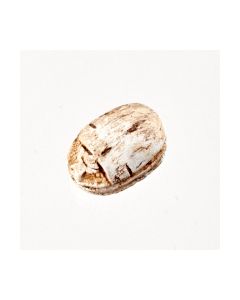 Scarab with lotus motive
Scarab with lotus motiveAncient Egyptian amulet seal with beautiful motive. Six lotus flowers are forming volutes. This scarab is described in the catalogue of Irène Gautier-Vodoz.
Price: on request Scarab with sphinx and Maat
Scarab with sphinx and MaatThe piece from the Ramesside period shows the goddess of truth and justice. Next to her is a name, probably that of pharao Mencheperre, who is famous as Thutmosis III.
Price: on request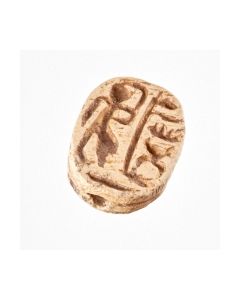 Scarab with cartouche
Scarab with cartoucheThe scarab from the late Ramesside period shows a standing person. A cartouche in front bears the name of pharao Mencheperre, who was famous as Thutmose III.
Price: on request Scarab with magic spell
Scarab with magic spellThe hieroglyphs are of the so called anra design, a magic spell in the ancient Egyptian belief. The scarab is from the 13th to 15th dynasty. It is described in the catalogue of Gautier-Vodoz.
Price: on request Scarab with geometric motive
Scarab with geometric motiveThe motive exhibits two symmetry axes and at least six triangles. A wonderful artistic expression of the highly evolved Egyptian maths. This scarab is described in the catalogue of Irène Gautier-Vodoz.
Price: on request Scarab with lion
Scarab with lionThe scene shows a walking lion. It is framed by an oval cord. This scarab is described in the catalogue of Irène Gautier-Vodoz.
Price: on request Scaraboid from the Middle Kingdom
Scaraboid from the Middle KingdomThe stamp shows hieroglyphs with a title for the king of Upper and Lower Egypt. This scaraboid is described in the catalogue of Irène Gautier-Vodoz.
Price: on request Cowroid with Ankh and papyrus
Cowroid with Ankh and papyrusThe seal is engraved with the breath of life between two papyrus plants. This scaraboid is described in the catalogue of Irène Gautier-Vodoz.
Price: on request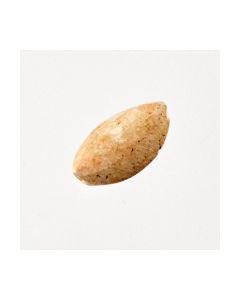 Cowroid with magic spell
Cowroid with magic spellThe hieroglyphs of the anra type are to be interpreted as magical formula. From the Second Intermediate Period of ancient Egpyt. This scaraboid is described in the catalogue of Gautier-Vodoz.
Price: on request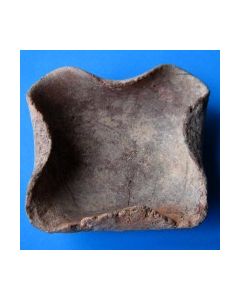 Seltene frühe Schalenlampe
Seltene frühe SchalenlampeKanaan, 2200 v.Chr. bis 1950 v.Chr., Frühe Bronzezeit IV bis Mittlere Bronzezeit I. Erster Lampentyp, Rarität. Fast perfekt erhalten. 100mm x 100mm, 35mm hoch.
Price: on request Pfeilspitze mit Widerhaken aus der Bronzezeit
Pfeilspitze mit Widerhaken aus der BronzezeitDie zwei Flügel sind dornartig zu Widerhaken nach unten gezogen. Großartiges Belegstück für eine Pfeilspitze aus der späten Bronzezeit mit Ähnlichkeit zu neolithischen Exemplaren aus Flint.
Price: on request Scarab with cartouche of Thutmose III.
Scarab with cartouche of Thutmose III.Amulet from the New Kingdom for one of the most popular rulers in ancient Egyptian history. This scarab is described in the catalogue of Irène Gautier-Vodoz.
Price: on request Scarab with falcon headed god
Scarab with falcon headed godInteresting scarab amulet from the Second Intermediate Period. The seal shows a falcon headed creature facing an Egyptian cobra. This scarab can be found in the catalogue of Irène Gautier-Vodoz.
Price: on request Scarab with pattern of circles
Scarab with pattern of circlesThe beetle stone bears a popular motive of the Middle Empire. A nice example of its kind. This scarab is described in the catalogue of Irène Gautier-Vodoz.
Price: on request Cowroid with decorated body
Cowroid with decorated bodyThe cowroid has an interesting decoration across the upper surface. The lower surface is inscribed with hieroglyphs. This cowroid is discussed in the catalogue of Gautier-Vodoz.
Price: on request Publizierter Tüllenmeißel aus der Bronzezeit - England
Publizierter Tüllenmeißel aus der Bronzezeit - EnglandPerfekt gearbeiteter Meißel aus Bronze. Grundform eines langgestreckten Kegelstumpfes. Wunderschöne gleichmäßige Patina. Ein Fund aus Ostanglien.
Price: on request Scarab with breath of life
Scarab with breath of lifeThe Ankh on the bottom side of this ancient egyptian scarab symbolized life or afterlife. The symbol is framed by volutes.
Price: on request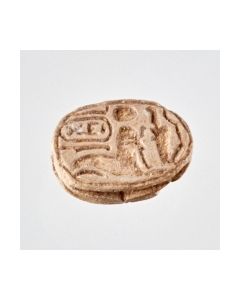 Memorial scarab for Thutmose III
Memorial scarab for Thutmose IIIA royal sphinx and Maat, the goddess of truth and justice adorn the lower side. Above them is the cartouche of Mencheperre. The piece is probably from the regin of Ramesses IV or V.
Price: on request Decorated socketed axe head with beautiful patina
Decorated socketed axe head with beautiful patinaBeilkopf aus der späten Bronzezeit Europas. Der Vorzug der Tüllenbeile gegenüber früheren Beiltypen besteht in der einfachen Schäftung mittels der Öffnung am Nacken. Museumswürdige dunkle Patina.
Price: on request Kleiner Axtkopf aus Bronze
Kleiner Axtkopf aus BronzeVotivaxt aus der Bronzezeit, 3. Jt. v. Chr. Modern ergänzt durch Schaft. Perfekt erhalten mit wundervoller Bronzepatina. Aus der Sammlung Weber.
Price: on request Ägyptisches Skarabäus Siegel
Ägyptisches Skarabäus Siegel12. Dynastie, 13mm lang. Kleine Beschädigung an Unterseite.
Price: on request Kanaanitischer Skarabäus
Kanaanitischer SkarabäusSpätes kanaanitisches Siegel in skaraboider Form, Frühe Eisenzeit. Historisch sehr interessante Darstellung eines Seegelboots mit einem Mast. Brauner Steatit, 14mm lang.
Price: on request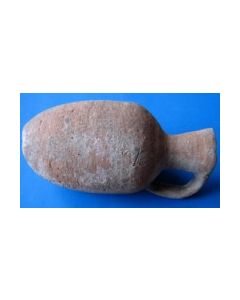 Großer kanaanitischer Henkelkrug der Bronzezeit
Großer kanaanitischer Henkelkrug der Bronzezeit2000 v.Chr. bis 1500 v.Chr., Mittlere Bronzezeit IIA/B. Großer, aber elegant geformter Krug mit Henkel und Ausguss. Vermutlich für Wasser, Wein oder Öl verwendet. Höhe 230mm. Breite maximal 100mm.
Price: on request Bronze socketed axe head from large collection
Bronze socketed axe head from large collectionSehr schönes Exemplar eines Bronzebeils vom Typ der sogenannten Tüllenbeile. Es stammt aus einer gut geführten Sammlung, die einen breiten Querschnitt europäischer Tüllenbeile abbildet.
Price: on request Bronze axe head with beautiful patina
Bronze axe head with beautiful patinaKörper mit ovalem Querschnitt und charakteristischer Öffnung am Nacken, für die einfache Schäftung des Beilkopfes. Derartige Beile wurden in der späten Bronzezeit als Arbeitsgeräte vielfältig eingesetzt. Spannendes Belegstück.
Price: on request Elegantly shaped socketed axe head with flat body
Elegantly shaped socketed axe head with flat bodyBronzenes Beil mit charakteristischer Öffnung am Nacken, für die einfache Schäftung des Beilkopfes. Derartige Beile wurden in der späten Bronzezeit als Arbeitsgeräte vielfältig eingesetzt. Eine Besonderheit ist der flache Körper.
Price: on request Bronze socketed axe head
Bronze socketed axe headKörper mit ovalem Querschnitt und charakteristischer Öffnung am Nacken, für die einfache Schäftung des Beilkopfes. Derartige Beile wurden in der späten Bronzezeit als Arbeitsgeräte vielfältig eingesetzt. Spannendes Belegstück.
Price: on request Socketed axe head with colourful patina
Socketed axe head with colourful patinaKörper mit ovalem Querschnitt und charakteristischer Öffnung am Nacken, für die einfache Schäftung des Beilkopfes. Derartige Beile wurden in der späten Bronzezeit als Arbeitsgeräte vielfältig eingesetzt. Spannendes Belegstück.
Price: on request Großes Skarabäussiegel aus der Zeit des Amenophis III.
Großes Skarabäussiegel aus der Zeit des Amenophis III.14. Jh. v. Chr. Heute noch erhaltene Überreste der Bautätigkeit Amenophis III. sind die Memnonkolosse, sowie der Hauptteil des Luxor-Tempels.
Price: on request Bronzedolch aus Nordiran
Bronzedolch aus NordiranGroßer Bronzedolch, aus zwei Teilen gefertigt. Um 1000 v. Chr. Museumswürdiges Exemplar, ex Bonhams, davor Sammlung Lady O. Hamilton.
Price: on request 32 seltene ägyptische Scheibenperlen aus Straußenei-Schalen
32 seltene ägyptische Scheibenperlen aus Straußenei-SchalenGruppe vorantiker Scheibenperlen. Prädynastische Zeit. Durchmesser um 13 mm. Exzellenter Zustand.
Price: on request

